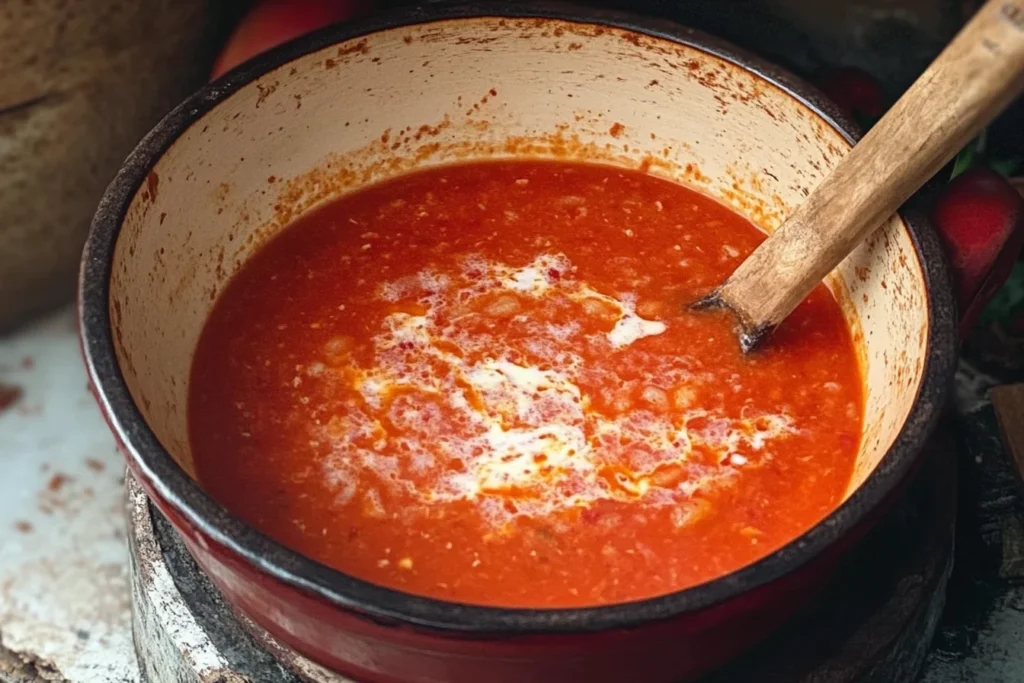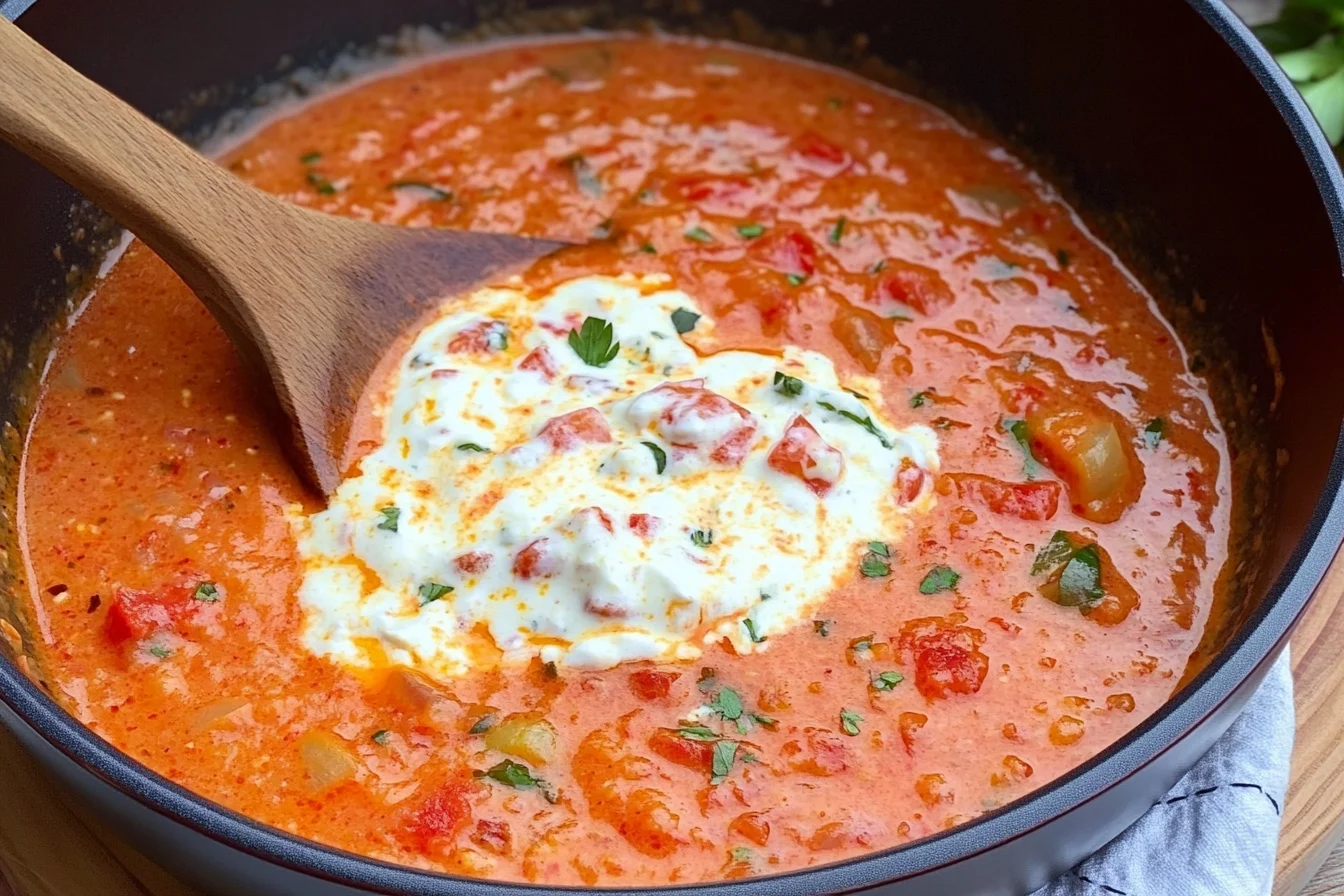Introduction to Tomato Gravy
Tomato Gravy recipe is a comforting, flavorful dish that can elevate any meal. Whether served over warm biscuits, hearty grits, or creamy mashed potatoes, this rich and versatile gravy is a favorite in both Southern and global cuisines. Easy to make and highly customizable, tomato gravy can fit into breakfast, lunch, or dinner menus with ease.

What Is Tomato Gravy?
Tomato Gravy combines tomatoes with a roux-based gravy, creating a velvety texture that marries the acidity of tomatoes with a creamy, savory base. It’s thicker than tomato sauce and often enriched with butter, cream, or a flavorful broth.
The Difference Between Tomato Gravy and Tomato Sauce
While both feature tomatoes, tomato gravy and tomato sauce differ significantly:
- Tomato Sauce: Typically thinner and used as a base for pasta or pizza.
- Tomato Gravy: Thicker, richer, and often served as a topping for biscuits, grits, or meats.
Popular Uses for Tomato Gravy in Cuisine
Tomato gravy is incredibly versatile and can be used in:
- Breakfast Dishes: Poured over biscuits or scrambled eggs.
- Southern Favorites: A topping for grits or fried chicken.
- Comfort Classics: Paired with mashed potatoes, meatloaf, or roasted vegetables.
Ingredients for Tomato Gravy
To make a flavorful tomato gravy, gather these core ingredients and flavor boosters.
Core Ingredients
Fresh Tomatoes or Canned Crushed Tomatoes
- Fresh Tomatoes: Ideal for a homemade touch. Blanch and peel for the best texture.
- Canned Tomatoes: Crushed or diced tomatoes provide convenience and consistent flavor.
Butter or Oil for the Roux
- Butter: Adds richness and depth.
- Oil: A lighter alternative that still creates a smooth base.
Flour for Thickening
- All-purpose flour is whisked into the butter or oil to form the roux, which thickens the gravy.
Liquid Base: Chicken Broth, Vegetable Stock, or Milk
- Broth or Stock: Adds a savory foundation.
- Milk: Creates a creamy, Southern-style gravy.
Flavor Enhancers
Onion, Garlic, and Bell Peppers
- Onions and Garlic: Provide a robust, aromatic base.
- Bell Peppers: Add sweetness and a hint of texture.
Spices: Paprika, Red Pepper Flakes, Salt, and Black Pepper
- Paprika and Red Pepper Flakes: Add warmth and a mild kick.
- Salt and Pepper: Balance and enhance the overall flavor.
Optional Additions: Sugar, Worcestershire Sauce, or Vinegar
- A pinch of sugar balances acidity, while Worcestershire or vinegar adds depth.
Optional Garnishes and Additions
Fresh Herbs: Parsley, Basil, or Thyme
- Sprinkle chopped herbs for a fresh, vibrant finish.
Bacon Bits, Sausage, or Ground Beef for Protein
- Transform the gravy into a heartier dish by adding cooked proteins.
Tools and Equipment Needed
Essentials for Cooking Tomato Gravy
Skillet or Saucepan for Cooking
- A deep skillet or medium saucepan is ideal for preparing and simmering the gravy.
Whisk for Making the Roux
- Use a whisk to create a smooth, lump-free roux.
Optional Tools for Enhanced Preparation
Blender or Food Processor for a Smooth Texture
- Puree the gravy for a silkier consistency if desired.
Ladle for Serving the Gravy
- A ladle ensures mess-free portioning when serving.
Preparing the Ingredients
A successful Tomato Gravy starts with properly prepared ingredients. From peeling fresh tomatoes to organizing spices, preparation ensures a smooth cooking process and optimal flavor.
Prepping the Tomatoes
Blanching Fresh Tomatoes for Easy Peeling (Optional)
- Step 1: Score an “X” on the bottom of each tomato with a sharp knife.
- Step 2: Bring a pot of water to a boil and prepare an ice bath.
- Step 3: Boil the tomatoes for 30 seconds, then transfer them to the ice bath.
- Step 4: Peel off the skins and dice the tomatoes.
This method removes the skins effortlessly and improves the texture of the gravy.
Using Canned Tomatoes for Convenience
- For a faster alternative, use canned crushed tomatoes.
- Opt for no-salt-added varieties to control seasoning levels.
Chopping Aromatics: Onions, Garlic, and Peppers
- Onions: Dice finely for even cooking and consistent flavor distribution.
- Garlic: Mince or grate for a robust aromatic base.
- Bell Peppers: Dice into small, uniform pieces to blend seamlessly into the gravy.
Measuring and Organizing Spices
- Measure out paprika, red pepper flakes, salt, and black pepper in advance.
- If using Worcestershire sauce or vinegar, have it ready to add during cooking.
Making the Tomato Gravy Base
The base of Tomato Gravy starts with a smooth roux and rich tomato incorporation.
Preparing the Roux
A roux serves as the thickening agent and foundation of the gravy.
Melting Butter or Heating Oil
- Heat 2 tablespoons butter or oil in a skillet over medium heat.
- Once melted or shimmering, ensure the fat doesn’t burn by keeping the heat moderate.
Whisking in Flour Until Golden Brown
- Add 2 tablespoons all-purpose flour to the butter or oil.
- Whisk continuously until the mixture turns golden brown and emits a nutty aroma. This step ensures the flour cooks fully, preventing a raw taste.
Adding Tomatoes to the Roux
Slowly Incorporating the Tomatoes and Breaking Them Down
- Gradually add the diced or canned tomatoes to the roux, stirring to combine.
- Use the back of a spoon to crush any large chunks, creating a smoother texture.
Adjusting Consistency with Broth or Milk
- Add 1–2 cups of chicken broth, vegetable stock, or milk, depending on your preferred consistency.
- Stir continuously to blend the liquid evenly with the roux and tomatoes.
Simmering the Tomato Gravy Recipe
Simmering allows the flavors to meld and the gravy to reach the desired thickness.
Adding Aromatics and Spices
Sautéing Onions, Garlic, and Peppers for Extra Flavor
- In a separate pan, sauté the diced onions, garlic, and bell peppers until softened and fragrant.
- Add them to the tomato and roux mixture, stirring to incorporate.
Stirring in Seasonings Gradually for Balance
- Sprinkle in the measured spices, starting with paprika, red pepper flakes, salt, and black pepper.
- Taste as you go, adjusting for personal preference.
Letting the Gravy Simmer to Combine Flavors
Stirring Frequently to Prevent Sticking
- Reduce the heat to low and let the gravy simmer for 10–15 minutes.
- Stir every few minutes to prevent sticking and ensure even cooking.
Adjusting the Thickness with Liquid or Cooking Longer
- If the gravy is too thick, add a splash of broth or milk to thin it out.
- For a thicker consistency, simmer uncovered for a few extra minutes.
Enhancing and Serving the Tomato Gravy Recipe
Once your Tomato Gravy has simmered to perfection, it’s time to enhance its flavor and texture with optional additions, garnishes, and serving suggestions. Whether you prefer a heartier dish or a vegetarian option, the following steps will help elevate your tomato gravy to a new level.
Adding Proteins or Vegetables
Transform your tomato gravy into a more substantial dish by incorporating proteins or vegetables.
Stirring in Cooked Sausage, Bacon, or Ground Beef
- Brown ground beef or sausage in a separate skillet, then drain excess fat. Stir it into the simmering tomato gravy for a robust, meaty version.
- Add crispy bacon bits for a smoky, salty twist that complements the rich gravy.
Including Spinach, Mushrooms, or Zucchini for Vegetarians
- Sauté spinach, sliced mushrooms, or diced zucchini until tender and mix them into the gravy for added nutrients and texture.
- For a heartier option, include roasted eggplant or bell peppers.
Garnishing the Gravy
Garnishes add visual appeal and a fresh pop of flavor to your gravy.
Using Fresh Herbs for a Pop of Color and Flavor
- Sprinkle chopped parsley, basil, or thyme over the gravy just before serving.
- Fresh herbs brighten the dish and pair well with its savory notes.
Adding a Dollop of Cream for Richness
- Swirl in heavy cream or sour cream for a richer, silkier texture.
- For a vegan alternative, use coconut cream or cashew cream.
Serving Ideas for Tomato Gravy Recipe
Tomato gravy’s versatility makes it a perfect companion for various dishes. Here are some serving ideas to showcase its rich flavors.
Over Biscuits, Grits, or Mashed Potatoes
- Biscuits: Pour tomato gravy generously over warm, flaky biscuits for a classic Southern breakfast.
- Grits: Combine with creamy grits for a comforting, hearty meal.
- Mashed Potatoes: Use the gravy as a topping for mashed potatoes to elevate your side dish game.
As a Sauce for Pasta or Meatloaf
- Toss with cooked spaghetti or penne for a quick and easy pasta dish.
- Drizzle over meatloaf or baked chicken for a flavorful finishing touch.
Dipping Sauce for Bread or Rolls
- Serve tomato gravy as a dipping sauce for crusty bread, garlic knots, or dinner rolls.
- Pair with focaccia for an Italian-inspired appetizer.
Variations of Tomato Gravy Recipe
Adapt the basic tomato gravy recipe to suit your preferences or explore global flavors.
Southern-Style Tomato Gravy
Adding Sugar for Sweetness and Milk for Creaminess
- Stir in 1–2 teaspoons of sugar to balance the acidity of the tomatoes.
- Replace part of the broth with milk for a creamier consistency that’s perfect for biscuits.
Spicy Tomato Gravy
Incorporating Jalapeños or Cayenne Pepper
- Sauté finely diced jalapeños with the onions and garlic for a spicy kick.
- Add a pinch of cayenne pepper or hot sauce to the simmering gravy for an extra layer of heat.
Italian-Inspired Tomato Gravy
Using Basil, Oregano, and Parmesan Cheese
- Stir in dried or fresh basil and oregano for Italian flair.
- Top with grated Parmesan cheese or a drizzle of olive oil for a rustic finish.
Tips for Perfect Tomato Gravy Recipe
To achieve flawless results every time, keep these tips in mind.
Achieving the Right Consistency
- Adjust the thickness by adding liquid gradually. For a thicker gravy, simmer longer or add an extra teaspoon of flour to the roux.
Balancing Acidity with Sugar or Cream
- If the gravy tastes too tangy, balance the acidity with a pinch of sugar or a splash of cream.
Preventing Lumps When Making the Roux
- Whisk constantly while adding the flour to the melted butter or oil to ensure a smooth, lump-free roux.
- Slowly incorporate the liquid base while stirring continuously for a seamless blend.
Storing and Reheating Tomato Gravy Recipe
Proper storage and reheating ensure that your tomato gravy retains its flavor and texture.
Best Practices for Refrigeration and Freezing
- Store leftover gravy in an airtight container in the refrigerator for up to 4 days.
- For longer storage, freeze the gravy in portioned containers for up to 3 months. Thaw overnight in the refrigerator before reheating.
Reheating Gently to Maintain Texture and Flavor
- Reheat the gravy on low heat in a saucepan, stirring occasionally to prevent sticking.
- If the gravy has thickened during storage, add a splash of broth, milk, or water to restore its original consistency.
Frequently Asked Questions (FAQs)
1. Can I Use Tomato Paste Instead of Fresh Tomatoes?
Yes, tomato paste can be diluted with broth or water to replace fresh or canned tomatoes. Start with 2–3 tablespoons of paste for a small batch of gravy.
2. How Long Does Tomato Gravy Last in the Fridge?
Stored in an airtight container, tomato gravy will stay fresh in the refrigerator for up to 4 days.
3. Can Tomato Gravy Be Made Ahead of Time?
Absolutely! Tomato gravy can be prepared a day in advance and reheated before serving. The flavors often deepen as it rests.
4. Can I Make This Recipe Vegan?
Yes, use vegetable stock instead of chicken broth and replace butter with plant-based margarine or oil.
5. What’s the Best Way to Avoid Burning the Gravy?
Cook on low to medium heat and stir frequently, especially after adding the roux and liquid.
Conclusion: Enjoying Homemade Tomato Gravy Recipe
Tomato Gravy is a comforting, versatile dish that brings warmth and flavor to any table. From its velvety texture to its customizable flavors, it’s a recipe that’s as satisfying to make as it is to eat.
Experiment with variations to suit your taste, and don’t be afraid to get creative with proteins, spices, and garnishes. Share this hearty dish with family and friends, and enjoy the simple pleasure of a homemade classic. Bon appétit!

Tomato Gravy Recipe
Equipment
- Skillet
- Whisk
- Wooden Spoon
- Knife
- Cutting Board
Ingredients
Main Ingredients
- 2 tablespoons butter
- 2 tablespoons all-purpose flour
- 1 cup milk
- 1 14.5-ounce can diced tomatoes or crushed tomatoes
- 1/2 teaspoon salt
- 1/4 teaspoon black pepper
- 1/4 teaspoon paprika optional, for added flavor
Instructions
- In a skillet over medium heat, melt the butter until it begins to bubble.
- Whisk in the flour and cook for 1-2 minutes, stirring constantly, to form a roux. It should be golden and smooth.
- Gradually add the milk, whisking continuously to prevent lumps. Cook for 2-3 minutes until the mixture thickens.
- Stir in the diced tomatoes, salt, black pepper, and paprika (if using). Simmer for 5-7 minutes, stirring occasionally, until the gravy reaches your desired consistency.
- Remove from heat and adjust seasoning if needed. Serve warm over biscuits, rice, or mashed potatoes.
